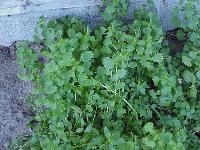Here in Highlands County, fireweed is emerging everywhere and becoming a nuisance for many of our livestock producers.
Fireweed is a native winter annual species in Florida. It is typically seen in north and central Florida on exposed areas within pastures (feeding troughs, mineral feeders, under fence and tree lines (forage grass is less prominent)).
 (Photo Credit: UF/IFAS)
(Photo Credit: UF/IFAS)
Weed Structure
Fireweed has stinging hairs that hold a toxin that easily inserts into the skin. When exposed to skin, the toxin creates irritation for several hours. Cattle typically avoid this weed but horses on the other hand, are more likely to try and browse this weed and can develop stress symptoms. Horses will show weight loss, difficulty swallowing and breathing for several days after grazing fireweed. In more severe cases, young horses have died from rolling around in this weed (over exposure to toxins in stinging hairs). Be careful, fireweed lives up to it’s name!!
 (Photo Credit: UF/IFAS)
(Photo Credit: UF/IFAS)
Fireweed’s leaves look similar to a strawberry plant, however the plant itself doesn’t strike any resemblance to a strawberry plant. They have square stems, small pale green flower clusters, and the stinging hairs are on the stems, petioles, and leaves. The hairs have a toxin that contains irritants causing respiratory stress and allergic reactions when ingested or inhaled.
Weed Control
Historically, not much research was conducted for the control of fireweed. However, this means recent studies have been conducted to gauge the effectiveness of pasture herbicides on this evil weed! Trials of 2,4 – D, Telar, glyphosate, and weedmaster were carried out, but none were consistently effective for control. It is recommended to use GrazonNext HL, Remedy Ultra, or Pasturegard HL for control of fireweed. These herbicides can be applied anytime of the year to warm-season forage grasses with no grazing restrictions for beef cattle. Lactating dairy animals must be removed 0-14 days with GrazonNext HL and Remedy Ultra, and completely removed for one season with Pasturegard HL.
Many producers try to mow fireweed down, but this method does not control this weed. It results in smaller plants with MORE stinging hairs. The seed has a sticky substance coating that attach to the mower’s blades for transport to non-infested areas, making the infestation worst.
Good News!
There is a silver lining! If you decide to not control fireweed, it has been seen to disappear in May when the summer temperatures arrive!
For more information on Fireweed control, click here or call the Highlands Extension office at 863-402-6540.
 0
0
